How to start a transformational mastermind group—in 7 steps
If you've been dabbling with the idea of starting a mastermind group because bringing together the brains and experience of several other entrepreneurs every week feels like a win for everyone (including you), we're glad you’re here!
Masterminds offer collective intelligence that speeds up time to success—and that’s exactly what makes them so powerful. We're about to teach you how to launch, run, and monetize a mastermind group. As well as how to join the right one if you're not ready to lead yet.
In this article, you’ll learn:
- The anatomy of a mastermind group
- How to start a mastermind in 7 steps
- The key to finding the right mastermind to join
What is a mastermind group?
The name is a little mysterious, but the idea is simple.
A mastermind group is a small group of people who meet regularly to help each other grow. They do this by keeping each other accountable, solving problems together, and giving honest feedback.
The concept goes back to Think and Grow Rich by Napoleon Hill. In 1937, he wrote about “the coordination of knowledge and effort... between two or more people, for the attainment of a definite purpose.” Today’s mastermind groups follow the same idea, just with more structure, better tools, and clear intention.
If you compare mastermind groups with other types of support models, like coaching, mentoring, or traditional networking (see the table below), you’ll find that mastermind groups don’t rely on a “guru” or top-down value.
Instead, the value flows laterally—from the experience, insights, and shared accountability of everyone in the group.
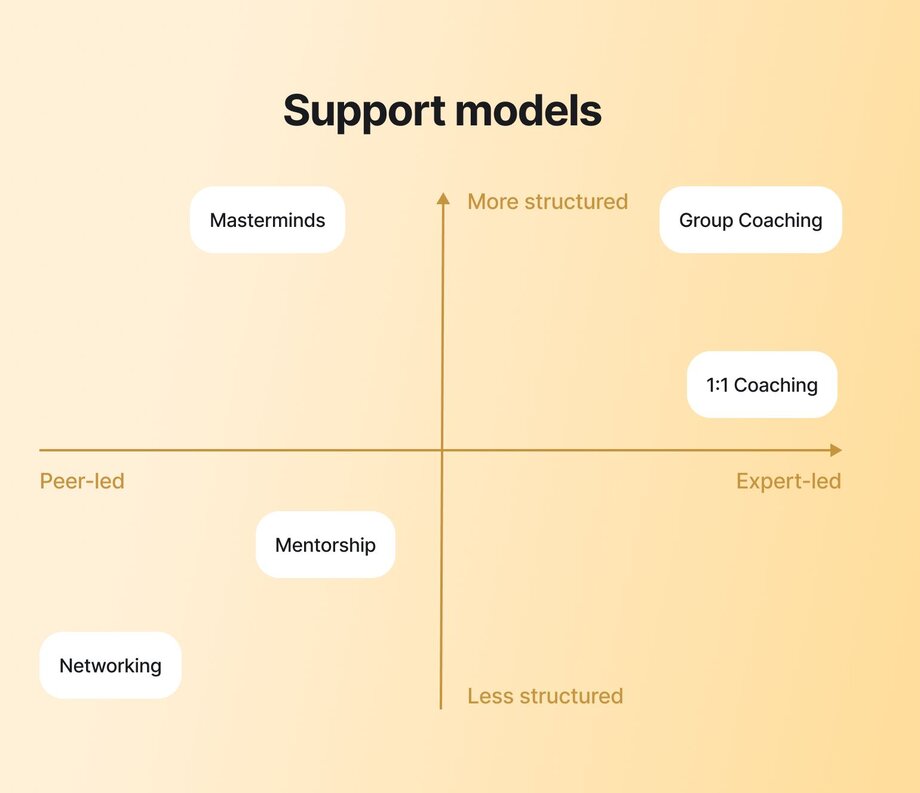
Here's another way to visualize it:
| Model | Structure | Role of facilitator | Value comes from |
|---|---|---|---|
| Mastermind group | Peer-based, structured | Often peer-led or lightly facilitated | Collective experience of the group |
| 1:1 coaching | One-on-one | Coach is expert or guide | Coach’s personalized guidance |
| Group coaching | Coach-led group | Coach is central authority | Coach's teaching + group support |
| Mentoring | One-on-one or informal group | Mentor shares from experience | Mentor’s personal insights |
| Networking group | Loose, often unstructured | No central guide | Connections + visibility |
The role of the facilitator in mastermind groups
If you want to start a mastermind group, chances are you’re going to be leading it. But that’s not the only way to go.
Some groups work well without a set leader. Members take turns running the meetings. Others choose a dedicated facilitator—this could someone from the group or someone you hire.
The facilitator’s role is to plan the agenda, guide the conversations, and keep things on track. They’re not there to dominate the conversation, but to make sure everyone gets a chance to contribute and that the group keeps moving toward its goals.
Not sure which setup to choose? Here’s a quick list of pros and cons for each.
| Structure type | ✅ Pros | ❌ Cons | Best for |
|---|---|---|---|
| Self-led (rotating members) | Everyone shares responsibility More affordable (no external hire needed) Builds leadership skills among members | Can lack consistency Harder to manage if group lacks initiative | Tight-knit groups Highly motivated and experienced members |
| Dedicated facilitator | Keeps meetings structured and focused Neutral party to manage conflicts Ensures consistent momentum | Can feel more 'managed' Hiring externally adds cost | New groups Groups that value strong structure or have diverse personalities |
You’ll also need to decide if the facilitator role should rotate or if you’ll hire someone from outside.
Rotating works when the group trusts each other and everyone feels okay taking turns leading. Hiring an outside facilitator can make meetings run more smoothly since they bring proven frameworks and know how to steer conversations to maximize value. Just keep in mind that hiring adds extra cost, which you’ll need to factor into your mastermind’s fee.
Key responsibilities and traits of a facilitator
Whoever takes on the facilitator role will need to:
- Guide the flow of each meeting: Kick things off with focused check-ins, keep discussions anchored to the agenda, and manage time so each person gets their moment.
- Keep group energy balanced: Make sure dominant voices don’t take over and the group feels like a safe place to share challenges—not just wins.
- Help members follow through: Recap action items at the end of each meeting, and follow up between sessions to help people stay accountable to their commitments.
- Spot patterns, not just problems: Over time, notice when people are getting stuck in the same places and gently challenge them to shift gears or try something new.
- Create continuity between sessions: Tie this week’s conversation back to what was said last time, so members feel momentum and progress.
➕ A good facilitator also needs to be empathetic, organized, and able to build trust.
Do mastermind groups really work?
The short answer? Yes. Otherwise, we wouldn’t be writing about them. But don’t just take our word for it — let’s look at some real examples.
Sarah Turner’s Write Your Way to Freedom started as a copywriting course and grew into a 7-figure mastermind community on Circle. It now has over 6,000 students. The group offers expert mentorship, weekly coaching, small niche groups, and peer masterminds. Many members have left 9–5 jobs, built freelance careers, and now work with brands like Google, Meta, and Forbes. Sarah’s community has made impressive numbers in sales and changed the lives of thousands.
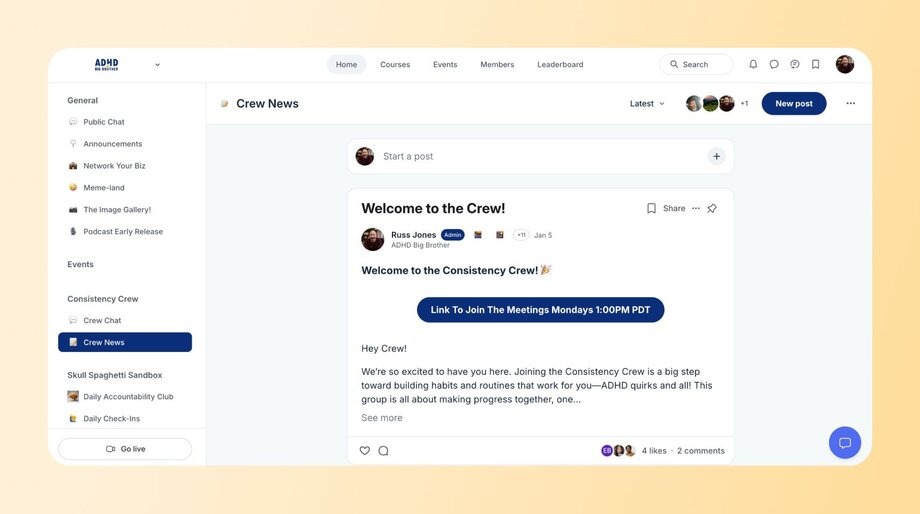
Another community and mastermind group delivering nothing short of a life-changing impact on adults with ADHD is Russ Jones’ ADHD Big Brother mastermind and accountability group. Designed as a judgment-free space, it offers daily accountability, monthly goal-setting chats, workbook clubs, and live coaching. Members consistently report significant improvements in focus, follow-through, and managing overwhelm, turning long-standing challenges into actionable wins.
“Adults with ADHD are great at doing the things that are of interest, but those awful important tasks always get pushed off, procrastinated, or completely forgotten. This small group (7 people max) helps not only to motivate and troubleshoot, but to get practice at weekly planning and weekly reflecting.
Once I learned that it’s ok to require accountability to get things done, that life isn’t about how able we are to do things without help…that’s when I really started taking off.”
—Russ Jones, host of ADHD Big Brother podcast and community builder
As a result of his masterminds and daily accountability groups (where he’s gamified members committing to one must-do task each day), he’s seen:
- One member ditched the job application deadline panic and now lands more job ops by applying early!
- Another went from chasing shiny objects to rocking a daily plan that actually works (and forgives slip-ups!).
- Someone else swapped “just-for-fun” tasks for power hours of billable work—and it’s paying off.
- One member just hit 400+ days straight of crushing their daily goal.
So, are mastermind groups worth it? Yes, absolutely. Whether you join one to level up your business or life, or decide to build your own, the potential payoff is real.
As a serial entrepreneur, Richard Branson once said, “Two heads are definitely better than one… by brainstorming as a team and sourcing ideas from each other, you have a better chance of coming up with a strategy that will allow your business to overcome a setback or challenge.”
That’s exactly what mastermind groups are designed to do. By combining different experiences, perspectives, and skills, members can solve problems more effectively than they would alone.
“We use fitness trainers to help keep us motivated and healthy, we use therapists to help process our past and move forward, and we use teachers to educate us on topics of interest. So it makes all the sense in the world to use community-and the accountability it can provide-to help us achieve our personal goals.”
—Russ Jones, host of ADHD Big Brother podcast and community builder
If you do launch your own, be intentional about who you recruit, set a clear structure, and run sessions in an organized way so everyone feels motivated and empowered to support one another.
Anatomy of a mastermind group
So, how do you actually run a mastermind that works? Let’s unpack the key building blocks.
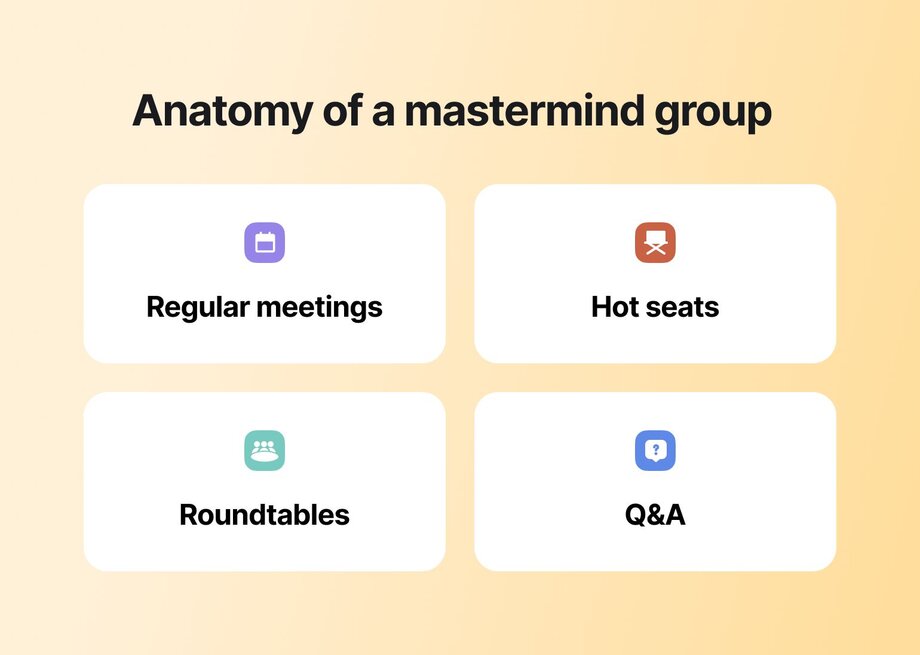
Format
Every mastermind group needs a rhythm for members to understand how to engage and get value. Here are the core elements most groups incorporate:
- Regular meetings (weekly, every two weeks, or monthly) to check in, share progress, and help each other.
- Hot seats: Each meeting, one member gets a chance to talk through a challenge or goal. The group listens and gives feedback.
- Accountability check-ins or roundtables: A quick round where everyone shares what they’ve done since last time and what they’re working on next.
- Open floor or Q&A: Time for questions that didn’t fit into the main agenda.
Tools needed
Unless your mind-reading group plans to meet by telepathy, you’ll need some basic tools:
- Video calls or a live streaming platform: Zoom or Google Meet.
- Shared docs: For notes, agendas, and tracking goals (Google Docs or Notion work well).
- Group chat: For updates and casual chats between meetings. Depending on where your group is hosted, Slack or Discord could be good options.
- Scheduling tools: Calendly or Google Calendar to book meetings.
But if wrangling 10 different apps sounds like a headache, you might want to try something more streamlined, like Circle. Circle lets you host community events, run live calls, share content, encourage member chats, and even create courses—all in one place, under your brand.
Duration and size
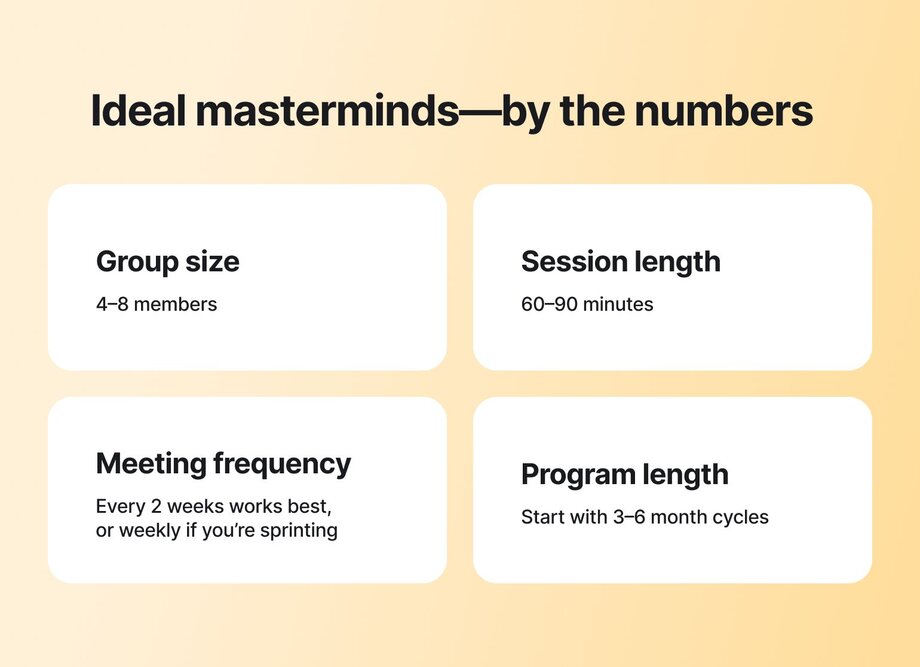
When it comes to running a mastermind group, smaller and focused almost always wins.
- Group size: Aim for 4–8 members.
- Session length: Plan for 60–90 minutes.
- Meeting frequency: Every two weeks works best. Weekly is fine for sprint-style groups.
- Program length: Start with 3–6 month cycles. It’s long enough to see progress but short enough to pivot if needed.
Mastermind ground rules
It’s not summer camp, but a few simple rules will help your mastermind run smoothly. Here’s what every group should agree on to keep sessions useful—and drama-free.
Confidentiality & psychological safety
What’s said in the mastermind stays in the mastermind. If members don’t feel safe sharing openly, you won’t get real breakthroughs. Set a clear rule from day one: no gossip and no leaks. Trust is built fast—and lost faster.
Plus, if running a mastermind group is your online business, focus on maintaining a strong reputation. Anything confidential leaking somewhere isn’t going to look (or feel) good!
Commitment
Masterminds only work if people show up. That doesn’t mean perfect attendance, but it does mean prioritizing the group. Set hard expectations during enrollment around showing up on time, being prepared, and following through on action items.
Participation & respect
Everyone should feel heard. Whoever is facilitating should make space for quieter members and help strong voices dial it back when needed. And above all, respect each other. Any hint of mockery or dismissiveness? Shut it down. Mastermind groups are a space for support and mutual growth, not judgment.
How to start a mastermind group in 7 steps
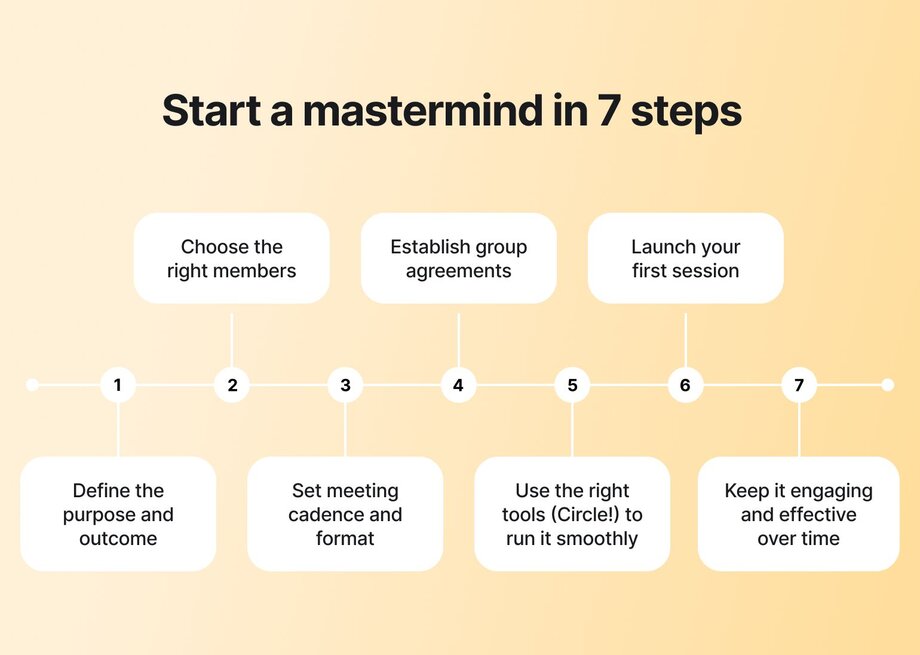
1. Define the purpose and outcome
What is this group really for? Before anything else, get clear on your purpose. Are you helping each other grow businesses, stay accountable to creative goals, or work through career transitions?
The purpose should feel specific enough to attract aligned people but broad enough to evolve over time. Ask yourself: What’s the ideal outcome for a member six months from now?
You can also add in broader, secondary goals that your community members may struggle with–like reducing isolation, encouraging deeper conversations, or providing support to finish projects or courses.
2. Choose the right members
Synergy within your group is everything. The right mix of members creates magic. But a mismatch? That can tank your momentum fast.
Look for people who are in a similar season, skill level, or entrepreneurial journey. If one person wants to scale to $10M and another is just starting out, the value might only flow one way. Because the person who is much further “ahead in business” will have little to learn from others and will end up mostly talking and helping others.
Keep in mind to choose people who are open-minded, willing to give and receive feedback, and committed to showing up.
3. Set meeting cadence and format
Scheduling might get tricky, especially with time zones and global members. Your goal? Find a day and time that the majority can consistently stick to. Avoid the “we’ll meet when we can” approach—it usually turns into “we never meet.”
Most groups meet every two weeks. Weekly can work if the group wants faster progress, but it’s a big commitment. Monthly can feel too spread out.
Also, decide how meetings will run upfront. Will you rotate hot seats? Have themed discussions? Bring in guest speakers? Pick a starting format, but be open to adjusting as the group finds its flow.

Allison Venditti runs Accountability Groups (masterminds) in her Moms at Work Collective to help moms move towards their goals, and her structure looks like this:
- Bi-weekly meetings for 70 minutes, for a total of 8 sessions
- Highs and lows check-in: Each session begins with a quick 2-minute update per person on personal or work related highs and lows to foster connection and support.
- Round tables: Two participants per meeting get 15 minutes each to present a short challenge and get feedback from the group.
- Rapid learning segment: Participants take turns sharing a quick recommendation—a quote, podcast, book, etc.—to inspire or aid others.
- Hot seat: One member per session gets a focused 30-minute session to dive deep into a specific challenge.
"Accountability groups help people get support, make friends and are also structured so people know they have time that is all their own. In a world that is focused on the loudest voice in the room making space for listening is critical to building community."
—Allison Venditti, Founder of The Collective
4. Establish group agreements
A good group culture needs clear rules. Agree on:
- Expectations
- Confidentiality
- Communication
- Participation
For example, in Allison’s accountability groups, there are two key principles:
- Curiosity over advice: Members are expected to be present, kind, supportive, and non-judgmental—offering listening and thoughtful questions over direct advice. Instead of giving prescriptive advice, members should ask clarifying questions and share relevant stories or examples.
- Hot seat preparation: The person in the hot seat should prepare a single, clear, actionable question in advance to maximize the value of feedback.
Write your mastermind rules down. Share them with everyone. And revisit them regularly to make sure they still feel aligned.
5. Use the right tools to host and run it smoothly
We really can’t overstate how important your mastermind’s backend tech is. For the smoothest member experience—and for your own sanity—you’ll want to invest in a platform that’s actually built to support these kinds of sessions and everything that happens around them.
With Circle, you can run live video calls, set up recurring events, organize spaces for different groups, share resources, and set up spaces for asynchronous discussion. You can also use bulk workflows to auto-match members into mastermind groups, and schedule recurring events. Basically, you can run your entire mastermind operations (and whole community or membership) from one, flexible tool!
6. Launch and facilitate the first session
Your first session sets the tone. You might feel nervous, but don’t aim for perfection! Instead, focus on making everyone feel welcome and clear on what to expect and how to participate valuably.
If you’re the facilitator, guide the agenda, keep the conversation flowing, and make space for every voice. Remind folks why they’re here, and celebrate the fact that you got this group off the ground.
7. Keep it engaging and effective over time through ongoing feedback & evolution
The best thing about masterminds is that they’re relatively small, which makes it easy to switch things up to better suit the group. Don’t stick to formats that aren’t working.
- If members’ personal commitments change, try finding a new meeting time.
- If people aren’t vibing with the sharing of resources, scrap it and allow people to engage async.
- If two round tables keeps running over, do one.
In short, keep asking for feedback, and be willing to adapt.
Common challenges in mastermind groups (and how to overcome them)
Managing personalities is part and parcel of the mastermind format. Some members naturally take the spotlight, while others prefer to observe, especially in the early days as the group finds its rhythm. Planning for these dynamics will help you create a more balanced and productive experience for everyone.
Uneven participation
Every group has its quieter members. But if some voices rarely get airtime, you’re missing valuable perspectives. This often shows up when check-ins run long or discussions meander without a clear structure.
🛠️ Solution: Create simple routines that give everyone a chance to talk, like short, timed check-ins. Rotate who leads. And check in privately with quieter members to see how you can support them.
One member dominates
There’s always going to be someone who talks more than their fair share, often without realizing it. It can wear others down and discourage contributions.
🛠️ Solution: Set clear but gentle rules about how long people can talk. Use a timer if needed. If you’re the facilitator, don’t be shy about stepping in to keep things balanced, especially during hot seats or feedback rounds.
Waning engagement
Low turnout. Late log-ins. Crickets in the group chat. Engagement dips are normal, but make sure they aren’t permanent.
🛠️ Solution: Reconnect to the group’s original purpose. Consider switching up the format. For example, you can add guest speakers, run themed sessions, or schedule a “reset” call to check in on why members aren’t engaging as much.
How much does a mastermind group cost (and earn)?
Mastermind groups can run the full spectrum—from free, peer-led circles to high-ticket, expert-led programs that act as the crown jewel of your offer suite.
Free groups are a great place to start if you’re just testing the waters. But here’s the hard truth: when no one’s financially invested, participation tends to slip. Paid masterminds (or masterminds as part of paid communities or offers), even at a modest fee, create commitment. Members show up, do the work, and take each other’s time seriously.
Pricing typically depends on three things:
👉 Who’s leading it (peer-led vs. expert-led)
👉 How long it runs (a few months vs. ongoing)
👉 What kind of access is included (community-only, small group coaching, or 1:1 support)
For example, the ADHD Big Brother group (mentioned earlier) uses a tiered model:
- Community access at $135/quarter includes workshops, accountability, and peer support.
- Small group coaching at $150/month offers weekly Zooms and hot seat coaching.
- 1:1 coaching runs $400/month for those wanting personal guidance.
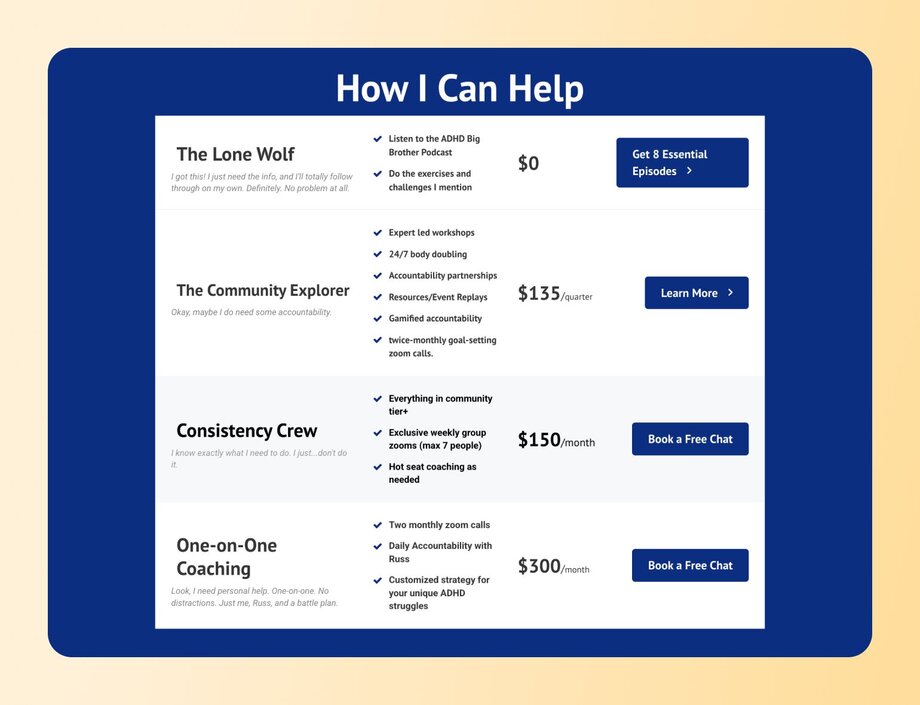
Similarly, the Talent Collective community on Circle has a
- Professional tier at $69/month for mastermind groups, networking, and workshops, while their
- Executive level at $2,899/year adds private leadership masterminds and executive coaching.
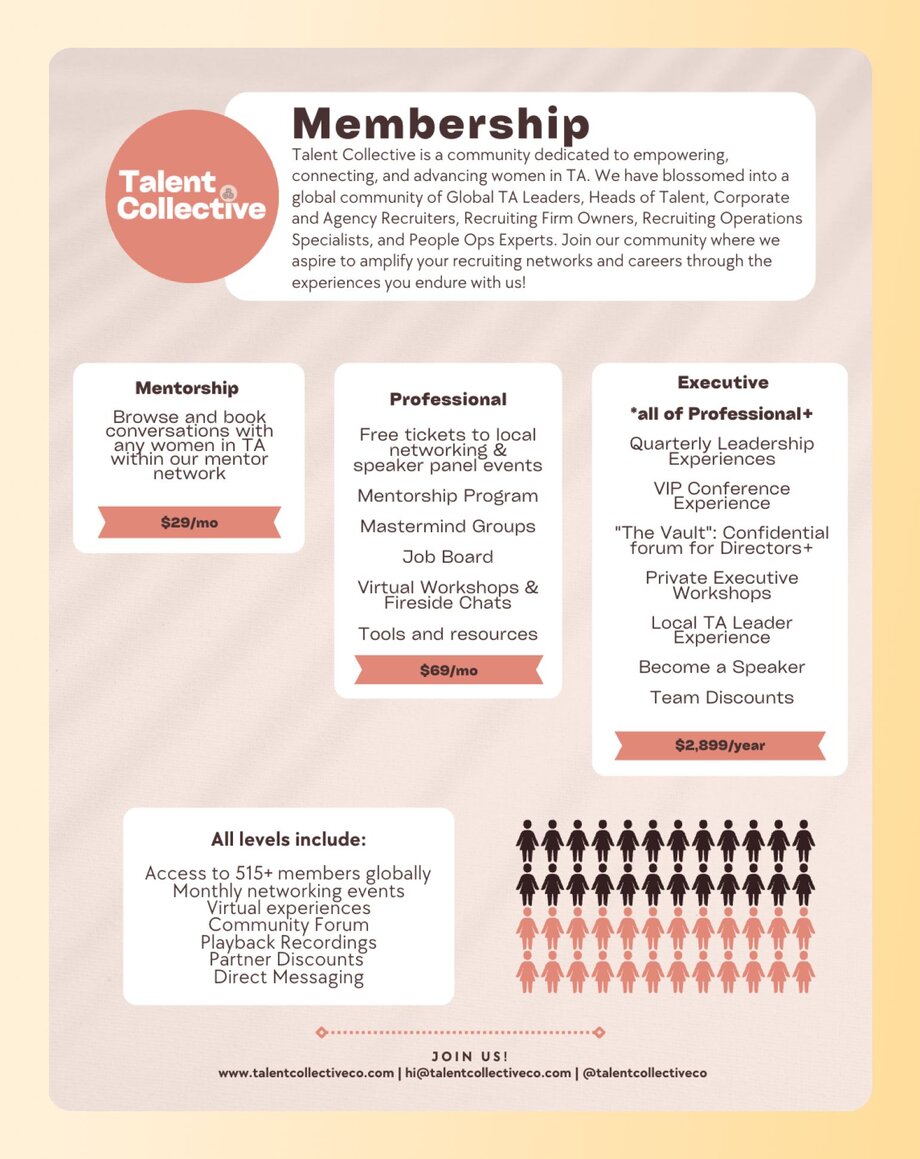
Generally:
- Community-based masterminds or resource access → lower monthly fees, scalable.
- Small group or 1:1 masterminds → higher pricing, more personalized support.
Tips for running a high-value mastermind
If you want your mastermind to stay helpful and productive, keep these tips in mind.
Create a shared agenda template
If you want your sessions to stay structured and useful, don’t skip the agenda. Create a shared template that mixes preset discussion topics with open slots for member requests—things like personal challenges, feedback on a pitch, or quick problem-solving.
Send the agenda before each meeting so everyone can prepare. Here’s a sample agenda to get you started👇
| Time | Activity | Description |
|---|---|---|
| 10 min. | Welcome & wins | Everyone shares one win from the past week. |
| 10 min. | Accountability round | Each member gives a fast update on last session’s action items. |
| 20 min. | Hot seat | One or two members dive into a challenge, question, or project. Group provides feedback. |
| 10 min. | Open floor | Free discussion or rapid-fire advice on member requests or spontaneous questions. |
| 5 min. | Upcoming actions | Each member states one action they'll take before the next session. |
| 5 min. | Wrap up & next steps | Confirm next session topic, facilitator (if rotating), and any prep needed. |
Rotate roles to prevent stagnation
Even if you have a facilitator, it’s a good idea to rotate roles to keep everyone engaged. Say you’re running a mastermind for personal fitness coaches. One week, a member might present a challenge like frequent client cancellations, while another moderates the discussion and someone else summarizes the group’s suggestions. Switching roles helps ensure everyone stays actively involved.
Address friction
If someone seems disengaged, check in privately to see how they’re doing. If it keeps happening, remind the group about expectations and give that person the option to either step back or re-engage.
Add rituals: wins, accountability circle, guest sessions
Give recognition for members’ accomplishments. Encourage everyone to share wins and hold each other accountable.
Moreover, if a need or challenge comes up that’s been voiced by multiple members, consider facilitating an extra session or offering to connect them with someone who can help. You can also toss in guest speakers occasionally to keep the group energized and looking forward to future sessions.
👉 Need more ideas? Learn how to create healthy community habits and rituals.
How to find and join an existing mastermind group
For most of this guide, we’ve talked about creating and launching a mastermind group.
But don’t rule out the option of joining one yourself. Many entrepreneurs end up building their businesses as lone wolves. It can feel isolating. You hit roadblocks and wish you had someone more experienced to ask, “What would you do here?”
As Jim Rohn famously said, “You are the average of the five people you spend the most time with.” If you’re looking for a supportive crew to push you forward, share wins, and swap practical advice, here’s how to find one to join.
What to ask before joining
- What’s the focus or purpose of this group?
- How are members selected or screened to ensure alignment and shared goals?
- How often does the group meet, and what’s the format?
- Are there opportunities for members to collaborate or network outside of regular meetings?
- What tools or platforms are used to support communication and accountability between sessions?
How to assess alignment and value
Look for a group where most members are at a similar stage—or a little ahead. Notice if people are engaged, supportive, and willing to collaborate (not compete).
If you leave an intro call feeling energized and motivated, that’s a good sign.
Where to find mastermind groups
The best way to join a mastermind is through a personal recommendation. Ask your network if they know of any groups accepting new members. Masterminds are built on trust and chemistry, so referrals are often the fastest path to finding a good fit.
If you don’t have a referral, try these options:
- Find out if people you admire host mastermind groups. Many thought leaders and successful entrepreneurs run private groups or cohorts.
- Look for local groups or people doing similar work. Research industry events or online communities where group coaching or masterminds might be mentioned.
- Explore business hubs like Whoggga. It’s a vetted community of growth-minded business owners who connect through authentic relationships to support each other’s business growth.
- Check out Circle’s Discover Directory. Browse curated communities, masterminds, and membership programs from trusted creators.
Hosting masterminds on Circle can be your secret weapon
Circle gives you everything you need to run effective, high-value masterminds—all in one place, under your own brand.
When you try to cobble together Zoom, Slack, Google Docs, and random email threads, you spend more time managing tech than designing and running a truly effective mastermind. Circle changes that.
Here’s how it can support your mastermind:
👉 Host live events with built-in video rooms and live streams for your weekly calls, hot seats, or Q&As.
👉 Set up private spaces for cohorts to keep discussions and resources organized and focused.
👉 Facilitate ongoing conversations with asynchronous chat threads so members can share wins and challenges between sessions.
👉 Set up accountability workflows to track progress and member check-ins.
👉 Centralize resources like docs, templates, and recordings under your brand—no more hunting for links.
Whether you’re building a small peer-led group or scaling a premium mastermind, Circle takes care of all the logistics.